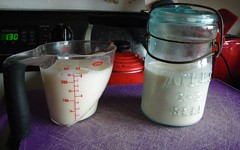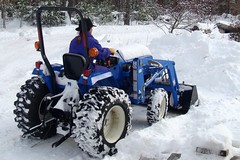 I was mentioning to our Hay Guy (Keith Short in Langdon, NH) that Ella Mae produces more and creamier milk on grass than on hay. He said he had just the thing — balage. We knew people fed that to their cows, but didn’t know if the sheep could eat it. When Lisa was talking to Sandy Davis up at American Way Farm about Maggie (our new rescue LGD), Sandy mentioned that she feeds it to her sheep and they love it. So last time Keith was here, he brought a bale of balage, also called haylage. Either way, it’s silage put up in a white plastic marshmallows. It’s not recommended for horses because they are hypersensitive to botulism but it’s ok for sheep as well as cows.
I was mentioning to our Hay Guy (Keith Short in Langdon, NH) that Ella Mae produces more and creamier milk on grass than on hay. He said he had just the thing — balage. We knew people fed that to their cows, but didn’t know if the sheep could eat it. When Lisa was talking to Sandy Davis up at American Way Farm about Maggie (our new rescue LGD), Sandy mentioned that she feeds it to her sheep and they love it. So last time Keith was here, he brought a bale of balage, also called haylage. Either way, it’s silage put up in a white plastic marshmallows. It’s not recommended for horses because they are hypersensitive to botulism but it’s ok for sheep as well as cows.
 We fed it to the cows and sheep Monday evening. It’s Sunday and they are still content, which is just crazy, and everyone spent much more time chewing their cud this week despite single digit (F) temps. Ella Mae’s production went back up albeit not to as much as when she was on grass. The cream line took a few days to come back, but it’s improving too. She’s now dripping milk in the morning when Lisa goes out to milk her, which hasn’t happened since right after she had Danny.
We fed it to the cows and sheep Monday evening. It’s Sunday and they are still content, which is just crazy, and everyone spent much more time chewing their cud this week despite single digit (F) temps. Ella Mae’s production went back up albeit not to as much as when she was on grass. The cream line took a few days to come back, but it’s improving too. She’s now dripping milk in the morning when Lisa goes out to milk her, which hasn’t happened since right after she had Danny.
The geese and ducks are loving it too. They pick at hay, but can’t really eat much, and end up eating a lot of grain in the winter. This week, despite having free-feed access to the grain, they’ve eaten about half of their normal rations. (Oddly, neither the chickens nor the turkeys have discovered it yet.)
On top of that, it costs ten bucks less a bale. We were feeding two bales a week to to the critters with horns, one to the horses, and half to a third to the pigs. So even in the unlikely event that we some day have enough pasture for the summer, that’s a bale a week saved for six months of the year, more with more critters.
Haylage is apparently what Walter Jeffries feeds his pigs in the winter so they are the next to try it. The pigs bed in their hay as well as eat it so we’re unlikely to save much volume. We’ll take the ten bucks though. (The pigs prefer to sleep outside in any weather except an ice storm, no matter how nice a shed we give them.)
 The only downside we’ve found is that at least in the cold, our NH TC30 tractor won’t lift the bales. (Weak hydraulics in cold is a known New Holland issue. The company denies it, honest dealers say to waste half an hour’s diesel to warm it up and it will work.) It might then be able to lift it. If so, we’ll have to mount the pond scoop off the three-point hitch in the back and load it with concrete blocks. The dry hay bales are exciting enough with no weight in the rear. Another few hundred pounds would
The only downside we’ve found is that at least in the cold, our NH TC30 tractor won’t lift the bales. (Weak hydraulics in cold is a known New Holland issue. The company denies it, honest dealers say to waste half an hour’s diesel to warm it up and it will work.) It might then be able to lift it. If so, we’ll have to mount the pond scoop off the three-point hitch in the back and load it with concrete blocks. The dry hay bales are exciting enough with no weight in the rear. Another few hundred pounds would
Still, better fed livestock for less money. Hard to beat.
I let my tractor warm up about 5 to 10 minutes (?) in the winter depending on the temperature. Once the engine’s warmed up I work the hydraulics gently to move the cold fluid around. After that it has plenty of power. This is a John Deere 4700 tractor. I do not like winter starts of it. There some things to make sure of:
– Good battery;
– Clean the battery terminals and tighten them in the late fall;
– Park where you can plug it in when necessary to boost it or warm the block;
– Park where you can get it out to a flat bed truck if necessary;
– Use the fuel additive for diesel in the winter if you have a diesel tractor;
– Listen carefully to the engine, starter, etc and don’t push it too hard;
– Never hit a tractor, it has a long memory.
We generally do the drive through the gate method of hay delivery because if we simply put the bale over the fence they push the hay up against the fence and damage it. I do have one place that sometimes ends up that way though.
As you note, dogs are a great help. One good dog equals five people when herding livestock.
I use a chain on grab hooks on my front bucket to lift and move round bales. See this post:
http://sugarmtnfarm.com/blog/2006/12/cottage-snowed-delivering-hay.html
This is a small welding job and a very cheap bale grabber.
This one is also along the same lines of this topic:
http://sugarmtnfarm.com/blog/2006/12/winter-hay-feeding-day.html
By the way, the link in my name in your post goes to your dead end page (404). I think it is missing the “http://” in the href.
I see you have some pallet fencing too. Very useful discards aren’t they!
Cheers,
-Walter
Sugar Mountain Farm
in Vermont
We started out using the chain method too. After about six months we bought an inexpensive bolt-on bale spear from Tractor Supply (we’re not too good to shop at Walmart either). If everything works I can use the bucket and spear to send the bale rolling far enough from the fence. Even if it doesn’t, I can climb the fence and roll a (dry) bale. Only the pigs really move a bale, and they don’t charge a gate. The sheep and cows by contrast are convinced that there must be real grass out there somewhere.